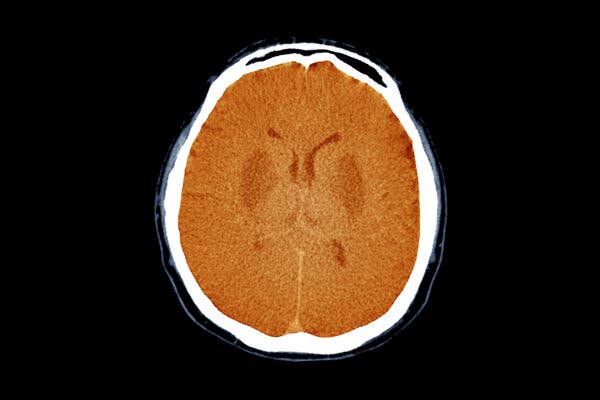Supported by
Unresponsive Brain-Damaged Patients May Have Some Awareness
Many patients thought to be in vegetative or minimally conscious states may be capable of thought, researchers reported.

When people suffer severe brain damage — as a result of car crashes, for example, or falls or aneurysms — they may slip into a coma for weeks, their eyes closed, their bodies unresponsive.
Some recover, but others enter a mysterious state: eyes open, yet without clear signs of consciousness. Hundreds of thousands of such patients in the United States alone are diagnosed in a vegetative state or as minimally conscious. They may survive for decades without regaining a connection to the outside world.
These patients pose an agonizing mystery both for their families and for the medical professionals who care for them. Even if they can’t communicate, might they still be aware?
A large study published on Wednesday suggests that a quarter of them are.
Teams of neurologists at six research centers asked 241 unresponsive patients to spend several minutes at a time doing complex cognitive tasks, such as imagining themselves playing tennis. Twenty-five percent of them responded with the same patterns of brain activity seen in healthy people, suggesting that they were able to think and were at least somewhat aware.
Dr. Nicholas Schiff, a neurologist at Weill Cornell Medicine and an author of the study, said the study shows that up to 100,000 patients in the United States alone might have some level of consciousness despite their devastating injuries.
The results should lead to more sophisticated exams of people with so-called disorders of consciousness, and to more research into how these patients might communicate with the outside world, he said: “It’s not OK to know this and to do nothing.”
When people lose consciousness after a brain injury, neurologists traditionally diagnose them with a bedside exam. They may ask patients to say something, to look to their left or right, or to give a thumbs-up.
A patient who doesn’t respond at all might be diagnosed as being in a vegetative state. A patient who produces only fleeting responses might be diagnosed as minimally conscious.
Starting in the late 1990s, Dr. Schiff and his colleagues took detailed scans of the brains of some patients with disorders of consciousness. While many of them turned out to have massive damage, others had surprisingly large swaths of intact tissue.
The neurologists wondered if at least some of the patients were still “in there” — and just couldn’t let anyone know.
A few teams of researchers began searching for signs of awareness. They first used a technique called functional magnetic resonance imaging to track the flow of blood through the brain.
In a 2006 study, Adrian Owen, then at the Medical Research Council Cognition and Brain Sciences Unit in Cambridge, England, and his colleagues asked a woman diagnosed as being in a vegetative state to imagine playing tennis.
Regions of her brain became active in response, imaging scans showed. They were the same regions that become active in undamaged brains.
The early studies left neurologists wondering whether such a condition — which Dr. Schiff calls cognitive motor dissociation — was rare. The only way to get an answer was to run a large survey.
Six groups of experts, including Dr. Owen’s and Dr. Schiff’s teams, began collaborating on a survey in 2008. To accelerate it, they figured out how to record brain activity in patients with an electrode-covered cap. It’s much easier to use electrodes to test patients at their bedside than to wheel them into a brain scanner.
Despite these advances, the work crept forward slowly. The researchers had to get permission from the families of patients to examine them, and then they had to carry out a standardized set of tests.
To make sure that false signals did not fool them, the researchers tried to get the patients to perform cognitive tasks over the course of several minutes.
The researchers tested 241 patients who did not respond to commands during a traditional exam. They also had healthy volunteers perform the same tasks. The researchers then handed the data over to a team of statisticians at the Icahn School of Medicine at Mount Sinai. The team performed the analysis without knowing which results came from which research group.
Their analysis revealed that 60 patients showed signs of awareness on the functional M.R.I. scans, electrode recordings, or both. The results were published in The New England Journal of Medicine.
Dr. Schiff said that the results may be biased by the fact that he and his colleagues examined the patients eight months on average after their injuries. The people who managed to survive that long might be more resilient than the ones who died sooner. And that resilience might have made them more likely to remain aware.
On the other hand, Dr. Schiff argued, the tests were so demanding that some patients with some awareness probably did not score positive results. “We’re likely to be missing people,” he said.
Dr. James Bernat, a neurologist at the Geisel School of Medicine at Dartmouth who was not involved in the study, said that it offered a definitive look at cognitive motor dissociation.
“This is, without a doubt, the largest study that’s ever been done” of these patients, he said. “It’s done by the best people at the best places, so we’re not going to be seeing a better one coming down the pike in a long, long time.”
It’s possible that people with disorders of consciousness may one day take advantage of brain implants that have been developed to help people with other conditions to communicate.
On Wednesday, another team of researchers reported that a patient paralyzed by amyotrophic lateral sclerosis, or Lou Gehrig’s disease, was able to communicate through a brain implant after just 30 minutes of training.
Dr. Schiff suspects that some people with cognitive motor dissociation will probably be able to master these implants.
“We have tens of thousands of people like that,” he said. “We should do something about it.”
Carl Zimmer covers news about science for The Times and writes the Origins column. More about Carl Zimmer
Discover More in Health and Science
Unresponsive, but Aware: Are brain-damaged patients thought to be in vegetative or minimally conscious states still aware? A large study suggests that some of them are.
Retrieving a Stolen Voice: In an experiment that surpassed expectations, implants in an A.L.S. patient’s brain allowed him to speak with the assistance of an A.I.-powered computer voice.
An Unexpected Heat Issue: Doctors and pharmacists say rising temperatures could be endangering people’s health by overheating mail-order medications.
A Stone’s Long Journey: A new study concluded that Stonehenge’s Altar Stone, a six-ton megalith at the heart of the archaeological site, traveled more than 450 miles to get there.
A Whale of a Mystery: Old Timer, the world’s oldest humpback whale, has endured in the Pacific Ocean, while some other humpbacks have struggled in a changing environment.
Advertisement
